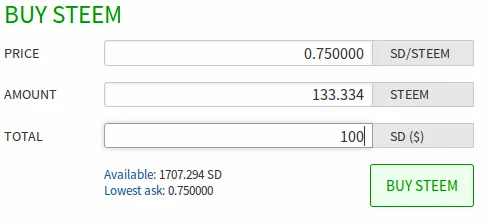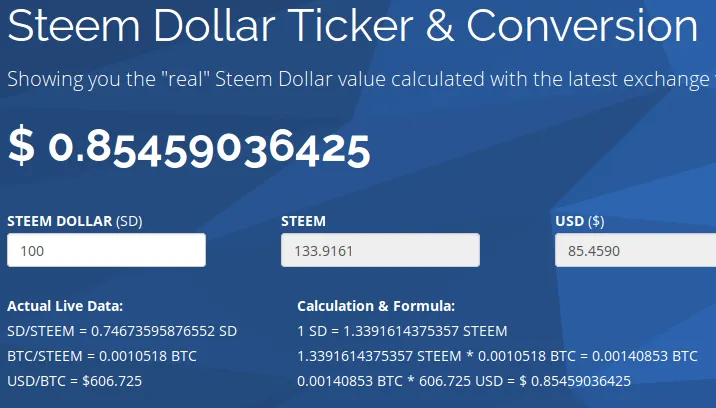Based on some of the conversations I've had, I think are some gaps in our understanding of Steem Dollar conversion. I'm going to be making 3 or 4 posts on the subject that should provide some benefit to even knowledgeable and experienced users.
I'm going to skip over all the preliminary stuff like "What are Steem Dollars?" and "How Do I Convert My Steem Dollars to STEEM?" And I also don't really want to debate whether you should then Power Up, or buy back SBD... That's beyond the scope of these posts.
This is mainly intended for people who already "get it" and might even convert already. It will hopefully contribute to your ability to assess whether and when it is a good idea. To do that, I'm going to take a look at a few individual players in this game.
For example, this week's star:
The 7 Day Median Average
This is the first of the three major determining factors determining the success or failure of any conversion. The other two will be identified in future posts.
This is what determines how many STEEM are produced by the quantity of SBD that you converted. It's the price you get for STEEM.
You can find the current 7 day median average on steemd.com:

As I write this, a 100 SBD conversion that was requested exactly 7 days ago and executing now would receive something like 141.044 STEEM.
100 / .709 ~= 141.04372
So, it's a pretty critical data point!
I'd like to point out two things about this number; it is Denominated in USD, and calculated using median average.
Denominated in USD
This is not readily apparent when you're looking at the feed, though it might be obvious for people familiar with the code than myself. The identifier used is SBD, which is hardly ever exactly equal to $1 USD.
But remember that 1 SBD is designed to represent $1 USD of value when redeemed in this manner. So if the price of SBD is lower than a dollar, it will produce more STEEM than could be purchased on the market.
When I can, I like to check relevant numbers to see if they confirm something like this...

Right now, on the internal market 100 SBD would buy 133.334 STEEM. And that's confirmed to track closely to the external markets as well. According to the SteemDollar.com ticker, 100 SBD is worth around 133.916 STEEM.

Of course, the price of STEEM is also lower now than the feed price quoted above. But the difference in buying power between SBD and USD made up for it. As long as we get more STEEM back than we could buy right now, it's been profitable.
Now that feed_price is a usable object for us, we can track its movements relative to the current price. It's a lot less volatile, and slow to respond to market changes. But it varies in how closely it tracks the actual market price. To get a feel for why, it helps to acknowledge the use of median average.
What is the median average, and why is this used?
In our everyday communication, most of us use the word "average" to describe what might otherwise be referred to as the "mean"... That is the sum of some number of values, divided by that number.
The average of 6, 9, 15, 43, and 46 is ( 6 + 9 + 15 + 43 + 46 ) divided by 5 (the number of samples). In this case, we get a (mean) average of 23.8.
The median average takes a different approach... it seeks to find the "middle value" in set of values. It eliminates the highest and lowest values, until it is left with just the middle value (or two values, which will provide a mean average).
In our example, the median average is... 15. The two highest values pulled up the mean average by 8.8 points, but they didn't have any effect on the median average. They could have been in the hundreds and it wouldn't have made a difference.
Many of us probably have some memory of that from grade school. If you're like me, it just kind of seemed like a waste of time. Oh great, another thing to memorize that I will never use again!
But there is a reason that the median is considered one of the most robust and resiliant statistics (Wikipedia says!). Half of the data set can be corrupted before the median average will be completely compromised. Using the median average is the best way to maintain the integrity of the feed that the conversion rate is based on.
The median average is used to prevent the following two abuses.
Corruption of the price feed.
The price feed is determined by the data reported by witnesses. If witnesses report incorrect data, it can have a major effect on the entire platform. The reward pool that supplies author and curator rewards relies on the feeds to produce an appropriate number of tokens, for example. And in our case... the feed determines how many steem we get for our conversion at the end of the week. Kind of a big deal, right?
In the case of conversions, a malicious witness could report an artificially low feed price in order to produce more STEEM from a conversion. Then when the time came, they could dump the STEEM on the market for an immediate profit... However, any given witness should never be relied on for 50% or more of the market data comprising the feed, so the median average renders this ineffective.
Market Manipulation
Market manipulation could occur when a user buys or sells large quantities of STEEM to artificially influence the price. They could sell off STEEM in order to depress the price and cause the conversion to produce more STEEM. Something like this would be a disaster, since not only would they be able to trick the system into providing more steem, but they would also contribute to lower rewards. Bad for everybody.
Market manipulation doesn't require you to be a witness. All you need is a pile of money and a desire to extract value at everyone else's expense. Spend enough time in crypto and you know there are plenty out there who fit the bill. And influencing the market will impact all the witness feeds, not just one.
But market manipulation is hard to carry out over a period of time. It's most effective in driving short term price fluctuations. It's easy to get the price of an asset to decrease over an hour or two... much harder to do over several days. Eventually you run out of tokens when you're selling them at a discount...
I hope that some of you might have gained some insight from this. In my next post, I'll discuss the market price of STEEM over time. I will use a recent conversion of my own to illustrate its effect on the return.